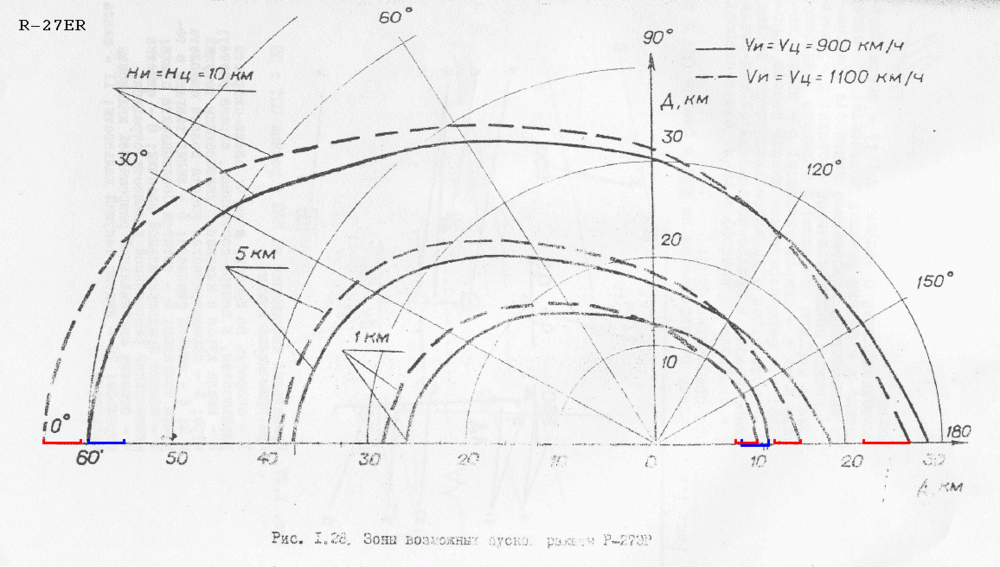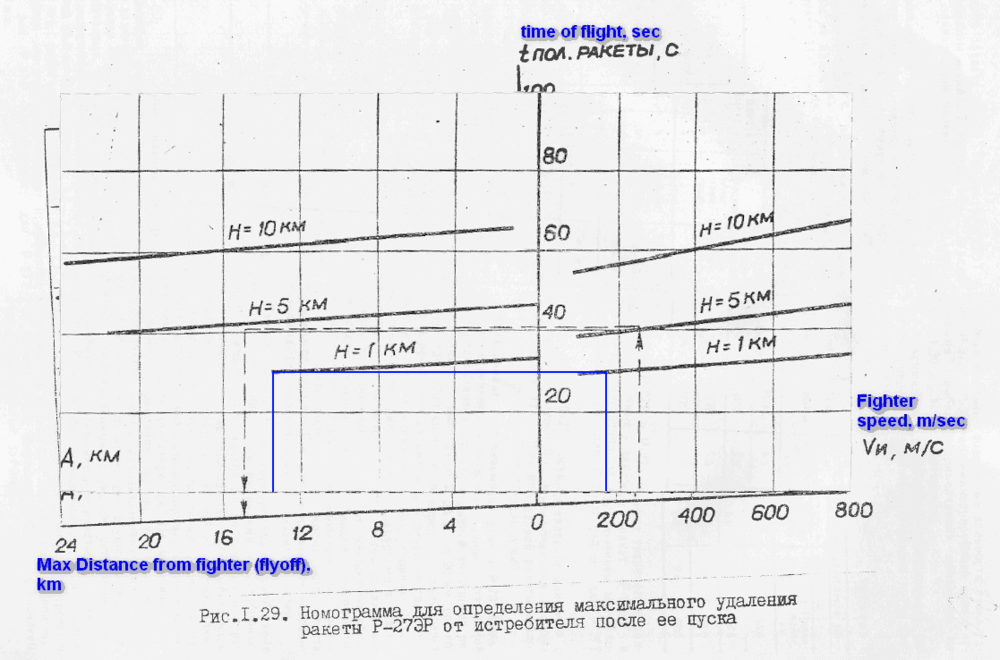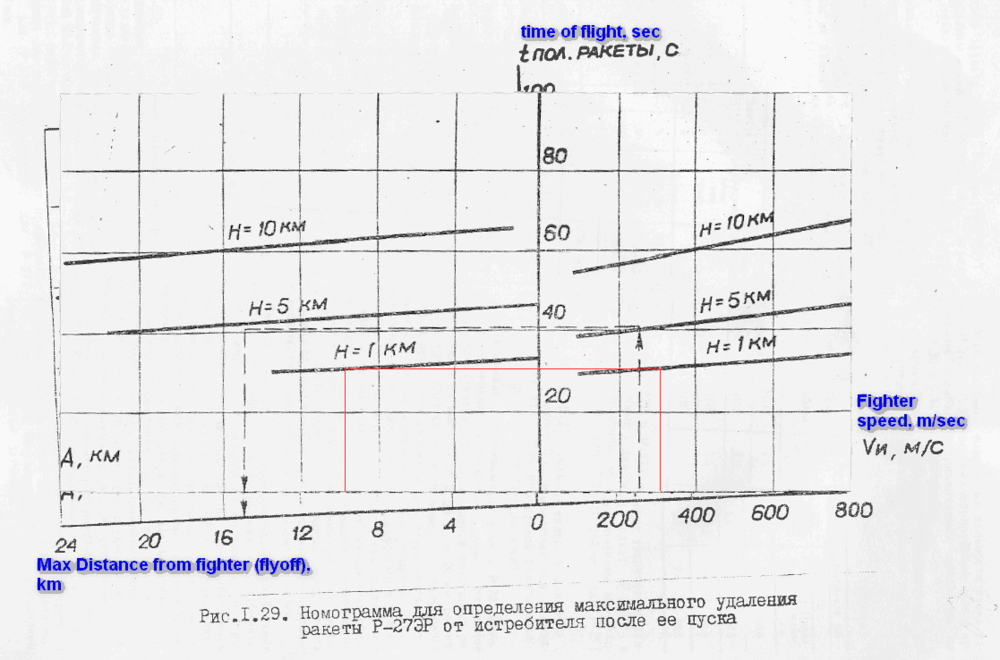-
Posts
939 -
Joined
-
Last visited
Content Type
Profiles
Forums
Events
Everything posted by BlackPixxel
-
Here I drew in some of the ranges from your SUV-27 sim. They are consinstently less. Do you really think such a huge, consistent error would be a result of hand drawing? Especially at times where the range would be exactly on the circle?? Absolutely not! Totally implausible! The actuall answer for the SUV-27 consistently showing reduced launch ranges should be that it includes a safety margin. For example to account for unprecise meassuring of the target coordinates. Or simply because a shot at maximum kinematic range is a wasted missile under real conditions. These range charts are the best you have. They should be taken seriously. If the missile does not reach the ranges of the chart, then the simulation is not accurate and needs to be improved. Especially concerning is the fact that the R-27ER WITHOUT base drag is not able to reach the range of the chart. For example, there were claims that the modelling of the atmoshpere is inaccurate, with too much drag down low and too little drag up high. If that is the case, then it is no suprise that after CFD the ER does not reach the correct range at 1 km altitude.
-
Well, not if one missile is modelled after the range charts (ER) and one is done with pure CFD and no base drag. Then the second missile has the advantage.
-
@Max1mus This is a Normogramm. You have to read it just as the arrows with the dotted lines indicate. If you want a flyoff of 13 km, then you have to fire it from a lower speed of about 170 m/s, which is just 600 km/h. Or did you fire it from 600 km/h and only achieve 9 km of flyoff?
-

reported AIM-120C losing targets easily for chaff even at close ranges
BlackPixxel replied to Comrade Doge's topic in Weapon Bugs
This is already what DCS is doing. Chaffing a missile when hot/cold is practically impossible, and the lower your radial velocity the higher the chance. To a certain degree this is also modelling the range cell impact, as with radial velocities close to 0 the chaff will stay longer in the range cell. -
The boost of the ER is based on real documents (7500 Kg according to a MiG-29 manual)
-
In DCS it is 3 + 7 seconds. Will it be changed to 2.5 + 6.5? Also, 9 seconds total instead of 10?
-
What do you mean with the body base drag? The effect of the rear of the missile on the deceleration is always ignored, not just when the motor is burning? I did not mean the total burntime, but how it is split up into boost and sustain. Right now it is 3 s boost and 7 s sustain. Are those values from documentation or guesses?
-
Does this already consider the reduced drag in the rear of the missile as long as the motor is burning? With a burntime of 10 seconds, this reduction in drag could have a significant impact Regarding the boost/sustain ratio: Is the current 3s/7s based on sources, or an educated guess?
-
Well, then either your CFD is bad or you have to increase the thrust of the motor. Because it has to reach the ranges specified in the charts.
-
You don't seem to understand. Your SUV-27 simulation always shows the range with around 15 % less than the kinematic range of the missile, as safety margin. Your SUV-27 simulation shows 7.95 km for 1 km. Add 15%, and you end up with around 9.14 km of range. Pretty much the value of the chart. Do you want to say now that the DLZ simulation also has the error in it? Was the code for that software hand drawn as well? But let's look at the flyout chart. I made it square to be easier to work with, and marked the flyout distance of the missile at 1100 km/h, which is at 306 m/s. It is slightly short of 10 km. If we now factor in the minimum closure speed for the proximity fuze to work (150 m/s), then it is no suprise that the launch range chart shows a little less. There is nothing to argue here, you have now seen from three different sources that the R-27ER flies quite far at 1100 km/h and 1 km of altitude. And this is how it should perform in DCS as well.
-
On the top left is not the target speed, it is the recommended speed for you to fly at. The target speed is not really shown, only the closure rate. It is on the right vertical line in the HUD. The arrow on this scale shows the closure speed, the small line below the arrow is the own aircraft speed, and the line at the bottom is the zero closure speed. If the target is flying directly towards the aircraft in this image, then its speed is quite low, it will be around 600 km/h. This is at least how I understood it from the SU-27SK manual, correct me if I am wrong! The length of the horizontal line in the top of the HUD shows the estimated flight time of the missile, full length is propably 60 seconds.
-
?? Chizh has a DLZ simulator of the real Su-27 SUV. It shows the same DLZ that the real aircraft would show. Permitted launch ranges from that simulation are below the ranges indicated in the graph by a pretty consinstent percentage. So it is pretty safe to say that the DLZ indicated in the HUD is less than the kinematic range, or the range shown in the chart in case of the Su-27 that we are talking about here.
-
Yes, the DLZ will show less range than the actual kinematic performance of the missile, propably to make sure that only shots with a decent chance of hitting are fired. So if the DLZ shows 7.95 km at 1 km altitude, then the missile will fly about 15 % further than that - which is pretty much exactly the 9.3 km from the chart.
-
Against your ridiculous claim, why don't you take a look at your Su-27 DLZ simulation software? In this post you made years ago, you wrote down the ranges at ZPS and 1100 km for fighter and target. In the aircraft DLZ, the ranges will always be lower, as you stated before. 1 km altitude Chart: 9.3 km DLZ: 7.95 km Difference: 1.35 km Reduction of 14.5 % 5 km altitude Chart: 14.45 km DLZ: 12.13 km Difference: 2,32 km Reduction of 16,1 % 10 km altitude Chart: 26,6 km DLZ: 22,01 km Difference: 4,59 km Reduction of 17,3 % Overall, the safety margin that is left with the DLZ at 1 km is perfectly in line with the other two. So the range in the chart is pretty accurate, and not a mistake at all. It also fits the range of the R-27ER flyout chart. Maybe instead of reducing 1100 km/h range, check if 900 km/h range should be higher to get your desired separation? I hope missiles in DCS will be modelled based on accurate data, and not on "I feel that the missile should not fly as far as shown in the graph".
-
Different chart, but it looks similar. But of course it is not the ED missile that is wrong, it is the real missile that is wrong!! R-27ER has massive thrust and a long burntime. Good range against rear hemishpere targets at low altitude is not a suprise.
-
Altitude difference is not enough to count as lookdown yet. Especially at this very long range. Get a bit closer and make sure that there is enough vertical separation for the lookdown penalty to kick in.
-
Might be the same document. Why would it not be a proper source?
-
Why only tail on? In the front hemishpere + lookdown at altitude it is also significantly underperforming. The MiG-29 is unable to engage high altitude head on targets if they are flying below it at ranges of more than 40 km, but it should be. Good luck with that, even against US aircraft equipped with Aim-7. Please consider the front hemishpere lookdown as well when fixing the radar! On top of that, MiG-29S should have about 15% better radar range than the earlier MiG-29. In DCS there is no difference.
-
No, there are range issues in head on look down and tail on for both look down and look up. About the doppler notch of active missiles: A while ago you said it was 20 m/s for ranges above 10 km and 10 m/s for ranges below. When does the doppler notch become 5 m/s? That is ultra narrow.
-
Last time I checked the Aim-120 in DCS was still able to find a target if support was cancelled a little later and the target did not maneuver. The main issue right now is that the loft is not completed. So as soon as support is dropped, it will keep its current direction, which is upwards if the support is dropped to early. This and the ECM bug are some issues that ED will hopefully solve soon.
-
The 4 is the same 4 that is used in the SARH guidance mode. So the resulting g-force at 50 km is 1,66 times higher than if the missile was already in auto tracking mode. That's what I meant. So it will result in a slightly higher energy loss than before.
-
As I already wrote above, I think I missunderstood the variable guidance coefficient on the R-27. It does not make the flight smoother, it actually will increase the overloads during the radio corrected phase compared to the SARH homing phase. For example, for a range of 50 km to target, the highlighted term in your image gives 50 km/(50 km-0.8*25 km) = 1,66... For a range of 25 km to target, it climbs to 25 km/(25 km - 0.8*25 km) = 5 So at a range of 25 km to the target in radio corrected mode, the overload of the missile will be 5 times as high compared to the overload of the missile at the same range in the SARH homing mode. This increasing overload is most likely there to make sure that the targets relative position towards the missile, projected onto the stabilized antenna plane, is as little as possible when the missile is supposed to switch to the SARH phase. So a proper implementation of this behaviour would be slowly increasing the coefficient in the table up to a maximum of 5 as it approaches a range of 25 km, and from 25 km to 0 km it should be fixed at 1. This will certainly cause the missile to bleed even more speed than usual, especially if the target rapidly maneuvers at ranges just above 25 km to the missile. Unless I am not understanding it correctly.
-
Ok, after looking at the document again and understanding all formulas in this section, I see what you mean. While it is variable PN, it actually works in the other way. The closer the missile gets to the defined seeker detection range, the more it tries to align the direction of the stabilized antenna with the target. And for that, the PN coefficient actually grows (it gets bigger than it is once the missile is doing the SARH tracking). But there is a limit to the growth, when the time constant T_y* gets smaller than 3.5 s it will be set to 3.5 s. For a typical medium engagement where the target flies 1000 km/h and the missile reaches roughly 4000 km/h, the value of T_y* will actually be 3,6 s when the missile is 25 km from the target, so this might be why they chose 3.5 s. If the antenna direction is still not aligned with the target at this range (projection of the target's position onto the antenna plane is not yet within 100 m for X and Y direction) then the missile will keep flying using radio correction until this condition is met, but the T_y* value will stay at 3,5 s. This prevents the missile from turning way to hard the closer it gets. The 3.5 s boundary and the condition for the switch to SARH homing can be found in this article: http://www.hups.mil.gov.ua/periodic-app/article/345
-
We are aware that the variable PN is only used during the radio corrected phase. This phase ends when the missile is 25 km from the target when engaging the typical target type (fighter aircraft). So just add a coeffs_table similar to this: PN_coeffs = {2, 25000.0, 1.0 50000.0, 0.25}; Doesn't need any rework of the flight model at all, as it is part of the old FM. It will certainly help the R-27R/ER And let's be realistic here: There is no way that we are going to see the R-27 rework sooner than 1-2 years. So why not make it as realistic as possible with the current FM, especially if such change can be implemented so easily?







